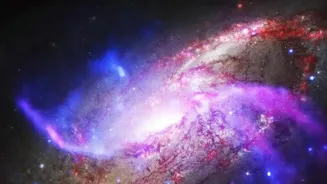Explore the fascinating journey of a photon, from the sun's core to Earth, revealing the secrets of light in space
Imagine the sun, our big, bright friend in the sky. It's constantly sending out light,
giving us warmth and making the world visible. But have you ever wondered exactly how that light, in the form of tiny particles called photons, makes its way from the sun all the way to Earth?

It's a fascinating story of a journey across vast distances and empty space. It seems nothing special, yet still continues to amaze people as it is the basic source of our ecosystem.
The journey starts with the sun where extreme heat is generated by nuclear reactions as atoms fuse together to produce light.
Photons journey from sun's core, scattering energy like a busy station
The journey of a photon begins deep inside the sun's core, where nuclear fusion reactions are constantly taking place. These reactions release immense amounts of energy, and this energy is what creates photons. Initially, these photons are not the sunshine we see. They are high-energy gamma rays.
Imagine them as tiny packets of energy, eager to start their journey. Now, the sun's interior is incredibly dense. It's like a giant, crowded city. So, the photons don't get to travel very far before they bump into something – another atom or particle.
Each collision changes the photon's direction and reduces its energy slightly. This process is called scattering. It's similar when you start your journey on a busy station. You bump into so many peole that it slows you down significantly.
Photons take ages to escape the sun due to constant collisions
This scattering process is incredibly slow. It takes a photon thousands, even millions, of years to make its way from the sun's core to its surface. Each time a photon collides with a particle, it gets absorbed and then re-emitted in a random direction.
This is like a never ending maze from which the photons have to escape in a random direction. Think of it like this: you're trying to walk across a crowded room, but every time you take a step, you bump into someone and have to change direction. It would take a long time to reach the other side!
The process is tedious and requires patience from the photons as they continue there journey through the sun. The collisions do not let the photons free easily.
Photons transform from gamma rays to visible light on the sun's surface
As the photons move further away from the core, they gradually lose energy. The journey is not easy and yet the photons persevere. By the time they reach the sun's surface, they are no longer gamma rays. They've transformed into lower-energy photons, like the visible light that we see.

The sun's surface, is known as the photosphere. This is where the photons finally get their chance to break free and travel into space. Before they become visible light which we see everyday, they are just high energy gamma rays produced from the sun.
The process of collision is very tedious which leads to the decrease in the energy of photons.
Photons travel at the speed of light in the vacuum of space
Now comes the exciting part! Once the photons escape the sun's surface, they embark on a journey through the vast emptiness of space. Unlike the crowded interior of the sun, space is mostly a vacuum. This means there are very few particles to get in the way.

As a result, the photons can travel in a straight line at an incredible speed – the speed of light which is almost 300,000 kilometers per second! Travelling in a vacuum helps the photons travel huge distances. Even from far away places light can be sent because vacuum offers very few obstructions.
The photons travel constantly without any change. This travel becomes possible only in the emptyness of the vacuum region.
Sunlight reaches Earth in 8 mins, warms, colors our world
The journey from the sun to Earth takes about 8 minutes and 20 seconds. That might seem like a long time, but considering the enormous distance, it's incredibly fast. Imagine travelling from Delhi to Mumbai in the blink of an eye! When these photons reach Earth, they interact with our atmosphere.
Some are reflected back into space, which is why we see the Earth from space. Others are absorbed by the atmosphere, providing warmth. And some pass through the atmosphere and reach the ground, allowing us to see the world around us.
This all continues to provide us warmth and makes us see the colours of the world which we live in.
AI Generated Content. Glance/InMobi shall have no liability for the content














